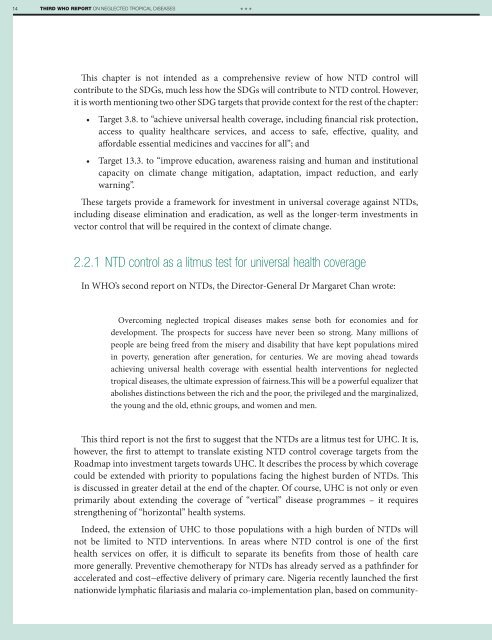1A9bnbK
1A9bnbK
1A9bnbK
Create successful ePaper yourself
Turn your PDF publications into a flip-book with our unique Google optimized e-Paper software.
14 THIRD WHO REPORT ON NEGLECTED TROPICAL DISEASES<br />
***<br />
This chapter is not intended as a comprehensive review of how NTD control will<br />
contribute to the SDGs, much less how the SDGs will contribute to NTD control. However,<br />
it is worth mentioning two other SDG targets that provide context for the rest of the chapter:<br />
• Target 3.8. to “achieve universal health coverage, including financial risk protection,<br />
access to quality healthcare services, and access to safe, effective, quality, and<br />
affordable essential medicines and vaccines for all”; and<br />
• Target 13.3. to “improve education, awareness raising and human and institutional<br />
capacity on climate change mitigation, adaptation, impact reduction, and early<br />
warning”.<br />
These targets provide a framework for investment in universal coverage against NTDs,<br />
including disease elimination and eradication, as well as the longer-term investments in<br />
vector control that will be required in the context of climate change.<br />
2.2.1 NTD control as a litmus test for universal health coverage<br />
In WHO’s second report on NTDs, the Director-General Dr Margaret Chan wrote:<br />
Overcoming neglected tropical diseases makes sense both for economies and for<br />
development. The prospects for success have never been so strong. Many millions of<br />
people are being freed from the misery and disability that have kept populations mired<br />
in poverty, generation after generation, for centuries. We are moving ahead towards<br />
achieving universal health coverage with essential health interventions for neglected<br />
tropical diseases, the ultimate expression of fairness.This will be a powerful equalizer that<br />
abolishes distinctions between the rich and the poor, the privileged and the marginalized,<br />
the young and the old, ethnic groups, and women and men.<br />
This third report is not the first to suggest that the NTDs are a litmus test for UHC. It is,<br />
however, the first to attempt to translate existing NTD control coverage targets from the<br />
Roadmap into investment targets towards UHC. It describes the process by which coverage<br />
could be extended with priority to populations facing the highest burden of NTDs. This<br />
is discussed in greater detail at the end of the chapter. Of course, UHC is not only or even<br />
primarily about extending the coverage of “vertical” disease programmes – it requires<br />
strengthening of “horizontal” health systems.<br />
Indeed, the extension of UHC to those populations with a high burden of NTDs will<br />
not be limited to NTD interventions. In areas where NTD control is one of the first<br />
health services on offer, it is difficult to separate its benefits from those of health care<br />
more generally. Preventive chemotherapy for NTDs has already served as a pathfinder for<br />
accelerated and cost−effective delivery of primary care. Nigeria recently launched the first<br />
nationwide lymphatic filariasis and malaria co-implementation plan, based on community-


